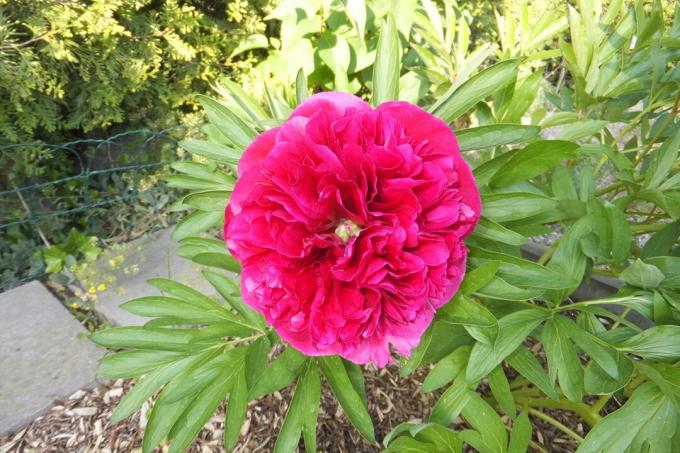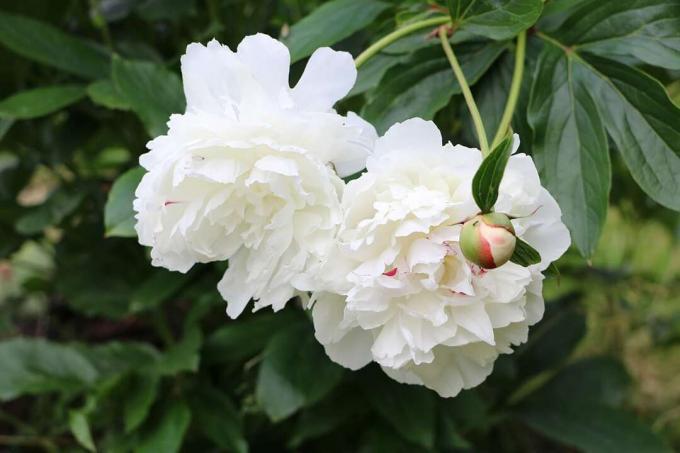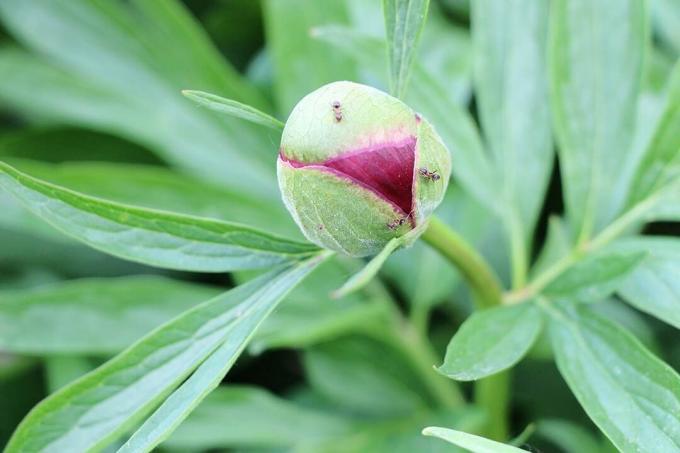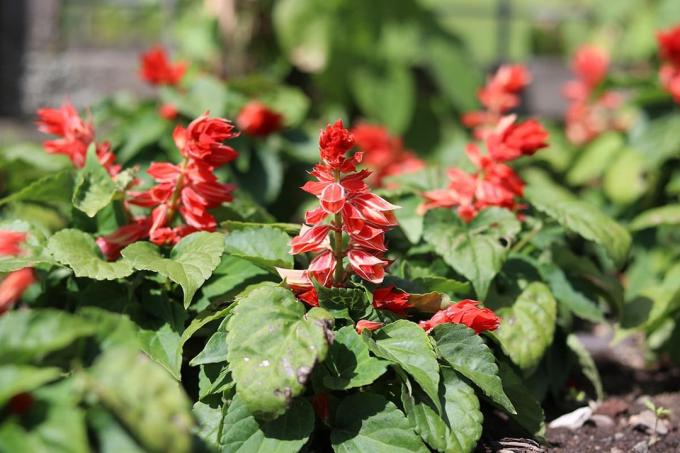

Table of contents
- Location
- substrate
- Plant
- Pour
- Fertilize
- waste
- Culture in the bucket
- propagation
- wintering
- plant neighbors
- Diseases
- leaf spot disease
- gray mold
- wilt disease
- pests
The peony is a real ornament for the garden and balcony, as the large flowers in particular have a decorative effect. With the appropriate measures, the plant can form new buds for a long time.
Location
The basis for the good growth of the peony is the right location. This should meet the following criteria:
- sunny and warm without the blazing midday sun
- sheltered from the wind
- away from larger plants with far-reaching roots
For example, the south side of the garden near a wall or a south-facing balcony are ideal.
Tip:
Cultivating peonies in a container can make it easier to find the right location. As a result, the plant can be placed in a more protected place, for example, in different weather conditions.
substrate
In order for the Paeonia to be resilient and adequately supplied, the soil must be tailored to the needs of the plant. The peonies need a substrate that has the following properties:
- permeable
- high clay content
- nutritious
Loamy soil that is loosened up with sand, gravel or coconut fibers is therefore well suited. Nutrients can be enriched with complete fertilizer for flowering plants or with well-rotted compost.
Plant
The peony can be planted both in spring and in autumn. The procedure is largely the same in both cases. Only the following steps and factors should be considered:
temperature
Planting should be done on a frost-free day. Since frost must be expected in both spring and autumn, it is advisable to plant the plants as late as possible in spring and as early as possible in autumn.
Preparation
In preparation for planting, a hole should be dug twice as wide and deep as the root ball. In addition, the substrate should be suitably prepared and enriched with nutrients. If necessary, it makes sense to lay a drainage. This prevents waterlogging.
pressing
Even if the soil should be permeable, the top layer must be pressed down well. Because soil that is too loose can make the roots susceptible to damage.

casting
Immediately after planting, the peony should be watered well. This continues to apply for the entire first year. When cultivated outdoors, the plant has then developed enough root mass to be self-sufficient outside of long dry periods.
Protection
Due to the risk of frost in both spring and autumn, the peony should be protected accordingly. A layer of straw, bark mulch, brushwood or putting on a plastic hood can prevent frost damage.
Pour
In the first year it is crucial to supply the plants with sufficient water. Well suited for this are:
- filtered or soft tap water
- collected rainwater
- pond water
Aquarium water can also be used. It is important that the water is low in lime. After the first year, the roots have grown so deep that regular watering is no longer necessary. It can be limited to watering as needed during dry seasons.
Fertilize
Peonies need nutrient-rich soil. The Paeonia should therefore be fertilized regularly. It is recommended to add nutrients in early spring, when budding begins. Suitable for this are:
- compost soil
- composted manure
- horn meal or horn shavings
- organic perennial fertilizer
Tip:
In addition to the spring dose, coffee grounds can be lightly worked into the top layer of soil once a month. Watering with pond water or aquarium water also contributes to the nutrient supply.
waste

With the peonies, the blend is very easy. It is sufficient to cut off the withered flowers after they have faded and to shorten all the shoots a hand's breadth above the ground at the end of October or beginning of November. On the one hand, this prevents the Paeonia from having entry points for pathogens and parasites. On the other hand, a strong budding in spring is promoted.
Culture in the bucket
There are slight deviations in the care of the Paeonia in the tub culture. Since less substrate is available, various measures are required. These include, among others:
- Fertilize every three to four weeks
- frost-free overwintering
- regular watering
- Repot at least every two years
In addition, care must be taken to ensure that no waterlogging occurs. Introducing a drainage layer at the bottom of the planter can prevent this. Coarse gravel, stones or ceramic shards are suitable for this.
propagation
There are two ways to propagate peonies. One is the division of the plant and the other is the sowing.
When repotting or transplanting the peony, the advantage is that the successes can be seen much faster. The plants bloom faster and recover from the measure in a shorter time. However, the large mother plant has to be divided for this, which at least temporarily results in a visual loss.
A notice:
Sowing seeds takes more time and requires more effort. However, the plant is spared.
wintering
If the peonies are cultivated outdoors in good time, light protection is sufficient. This can consist of a support on the ground or a cover.
If, on the other hand, the peony is cultivated in a bucket, it should be overwintered frost-free. If accommodation in the house is not possible, insulation can make sense. A pad made of styrofoam or a pallet is recommended, as is covering with fleece.
plant neighbors
Ideal plant neighbors for Paeonia are perennials that have the same requirements. This means that you need sunny locations and permeable but nutrient-rich and slightly loamy soil.
This applies, among other things, to:
- lady's mantle
- delphinium
- cranesbill
- Turkish poppy
Diseases
Diseases of the peonies can often be traced back to care errors. Because if the plants are weak or the cultivation conditions are not ideal, germs can penetrate more easily.

leaf spot disease
Leaf spot disease causes light to dark brown spots to appear on the leaves. They dry up or wither as a result. Early removal is advisable in any case. A fungicide can also be used.
gray mold
Gray mold is by far the most common disease in peonies. The risk of this increases if:
- the floor is used up
- there is not enough space between the plants
- waterlogging exists
- warm and humid weather prevails, such as in spring
Buds and entire shoots may turn brown and die. In these cases it is important to cut off as much of the wilted plant parts as possible and also to use a fungicide. In addition, an adjustment of the care, for example by a greater distance, the thinning out of shoots and the laying of a drainage makes sense.
wilt disease
With wilt disease, buds and shoots turn brown and wither. However, these signs are only the visible symptoms. However, the fundamental problem is found underground as the roots die off. Again, a lack of nutrients and excessive moisture are responsible.
To save the crop, the following steps are required:
- Dig up the plant and remove the substrate.
- Remove dead roots with a sharp, clean knife or sanitized scissors.
- So that the interfaces can dry, they should be stored outside the ground for a few hours. A fungicide can also be used.
- To prevent re-infestation, the substrate must be replaced and made more permeable.
Tip:
Diseased parts of plants and soil containing spores should be disposed of with household waste and not composted. However, soil can also be disinfected by heat, for example in the oven.
pests
Lice, caterpillars and snails are no problem for the peonies. Occasionally there are numerous ants on plants, but they hardly cause any damage.
 garden editorial
garden editorial I write about everything that interests me in my garden.
Learn more about perennials

20 hardy plants that bloom all year round
With plants that flower all year round, you can quickly create an attractive garden that does not require much maintenance, as long as the plants are also hardy. In this post, we will introduce you to 20 plants that are suitable for this.

17 flowering hardy plants May to October
Many plants only show their full splendor for a short time. But there are also types and varieties with a particularly long flowering period from May to October, sometimes even longer. We present 17 flowering hardy plants.

Hardy perennials: 22 perennial bloomers
Hardy perennials as permanent bloomers in the flower bed enchant the garden from early summer to autumn with a colorful bloom. They are easy to care for and magically attract butterflies, bees and the like.

10 care tips for the banana tree
If you like it exotic, cultivate a banana tree as a houseplant or in the conservatory. In summer, the banana plants are even allowed outside for a few weeks. The large leaves that the Musa forms on a false trunk are particularly decorative and impressive, and therefore look like a small tree.

Properly care for globe thistle | 10 tips for care
The globe thistle is an eye-catcher in the garden. Their spherical flowers provide a food source for insects. The globe thistle is not difficult to care for and it is suitable for dry locations. With a few tips on care, the plants will develop even better.

Fire sage, Salvia splendens: care from A to Z
Fire sage is known in botanical jargon as Salvia splendens and is a particularly decorative eye-catcher. But what kind of care does the plant need? Our guide to the salvia shows the important points from A to Z.
